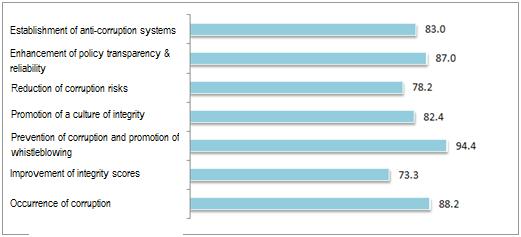ACRC publishes the result of the 2014 Anti-Corruption Initiatives Assessment
- Date2015-02-05
- Hit3,261
On February 5, the ACRC released the result of the 2014 Anti-Corruption Initiatives Assessment for 254 public organizations, including central government agencies, metropolitan or provincial governments, offices of education, and public service-related agencies.
In addition to the Integrity Assessment, which is designed to measure the integrity levels of public organizations by surveying citizens and public officials, the ACRC carries out the Anti-Corruption Initiatives Assessment every year to evaluate the effectiveness and achievements of the anti-corruption activities implemented by each public organization.
The 2014 Anti-Corruption Initiatives Assessment was conducted on the anti-corruption activities and achievements of 254 organizations from November 2013 to October 2014. The assessment criteria consists of seven components including "establishment of anti-corruption systems," "enhancement of policy transparency & reliability," "reduction of corruption risks," "promotion of a culture of integrity," and "prevention of corruption and promotion of whistleblowing." The average score for the assessment results was 83.2 points out of 100.

The average scores for 2014 Anti-Corruption Initiatives Assessment by criteria
The Ministry of Science, ICT and Future Planning, Military Manpower Administration, Busan Metropolitan City Government, and Korea District Heating Corporation got the highest scores among the organizations in each group. About 40 organizations, including Busan Metropolitan City Government, Daegu Metropolitan Office of Education, and Korea District Heating Corporation, have recorded Grade 1 or 2 at the Anti-Corruption Initiatives Assessment for three consecutive years. Moreover, 4 organizations, including the Ministry of Trade, Industry and Energy, Gyeongsangbuk-do Provincial Government, and Korea Communications Commission, raised their grades by more than 3 compared to the previous year.
The best practices identified through the assessment included extension of the period of limitations for disciplinary measures against graft and embezzlement of public funds to 7 years (Korea Technology Finance Corporation); stipulation of the measures against corrupt officials in the Guidelines on Budget Management for Public Enterprises and Quasi-Government Organizations, such as reduction of severance pay and prohibition of allowance payment for voluntary retirement (Ministry of Strategy and Finance); improvement of investigation direction and objection systems within the police department to prevent corruption caused by unfair direction of investigation and misuse of direction authority (National Police Agency); and creation of the Guidelines on Operating the Code of Conduct by Position and Duty (Korea Workers' Compensation and Welfare Service).
According to the result of the Anti-Corruption Initiatives Assessment, the ACRC will select the best organizations and persons of merit to recommend for government awards and provide incentives of overseas training, while providing policy consulting service for the organizations with poor results and reviewing their implementation of recommended improvement tasks.
The ACRC will enhance the evaluation on the practical efforts of public organizations to fight against corruption so that they can participate in the reform of the public sector by voluntarily reviewing and improving their corruption-causing systems. The Commission is also planning to include in the evaluation more organizations that have direct contact with the people, such as national and public university hospitals.
In addition to the Integrity Assessment, which is designed to measure the integrity levels of public organizations by surveying citizens and public officials, the ACRC carries out the Anti-Corruption Initiatives Assessment every year to evaluate the effectiveness and achievements of the anti-corruption activities implemented by each public organization.
The 2014 Anti-Corruption Initiatives Assessment was conducted on the anti-corruption activities and achievements of 254 organizations from November 2013 to October 2014. The assessment criteria consists of seven components including "establishment of anti-corruption systems," "enhancement of policy transparency & reliability," "reduction of corruption risks," "promotion of a culture of integrity," and "prevention of corruption and promotion of whistleblowing." The average score for the assessment results was 83.2 points out of 100.

The average scores for 2014 Anti-Corruption Initiatives Assessment by criteria
The Ministry of Science, ICT and Future Planning, Military Manpower Administration, Busan Metropolitan City Government, and Korea District Heating Corporation got the highest scores among the organizations in each group. About 40 organizations, including Busan Metropolitan City Government, Daegu Metropolitan Office of Education, and Korea District Heating Corporation, have recorded Grade 1 or 2 at the Anti-Corruption Initiatives Assessment for three consecutive years. Moreover, 4 organizations, including the Ministry of Trade, Industry and Energy, Gyeongsangbuk-do Provincial Government, and Korea Communications Commission, raised their grades by more than 3 compared to the previous year.
The best practices identified through the assessment included extension of the period of limitations for disciplinary measures against graft and embezzlement of public funds to 7 years (Korea Technology Finance Corporation); stipulation of the measures against corrupt officials in the Guidelines on Budget Management for Public Enterprises and Quasi-Government Organizations, such as reduction of severance pay and prohibition of allowance payment for voluntary retirement (Ministry of Strategy and Finance); improvement of investigation direction and objection systems within the police department to prevent corruption caused by unfair direction of investigation and misuse of direction authority (National Police Agency); and creation of the Guidelines on Operating the Code of Conduct by Position and Duty (Korea Workers' Compensation and Welfare Service).
According to the result of the Anti-Corruption Initiatives Assessment, the ACRC will select the best organizations and persons of merit to recommend for government awards and provide incentives of overseas training, while providing policy consulting service for the organizations with poor results and reviewing their implementation of recommended improvement tasks.
The ACRC will enhance the evaluation on the practical efforts of public organizations to fight against corruption so that they can participate in the reform of the public sector by voluntarily reviewing and improving their corruption-causing systems. The Commission is also planning to include in the evaluation more organizations that have direct contact with the people, such as national and public university hospitals.









